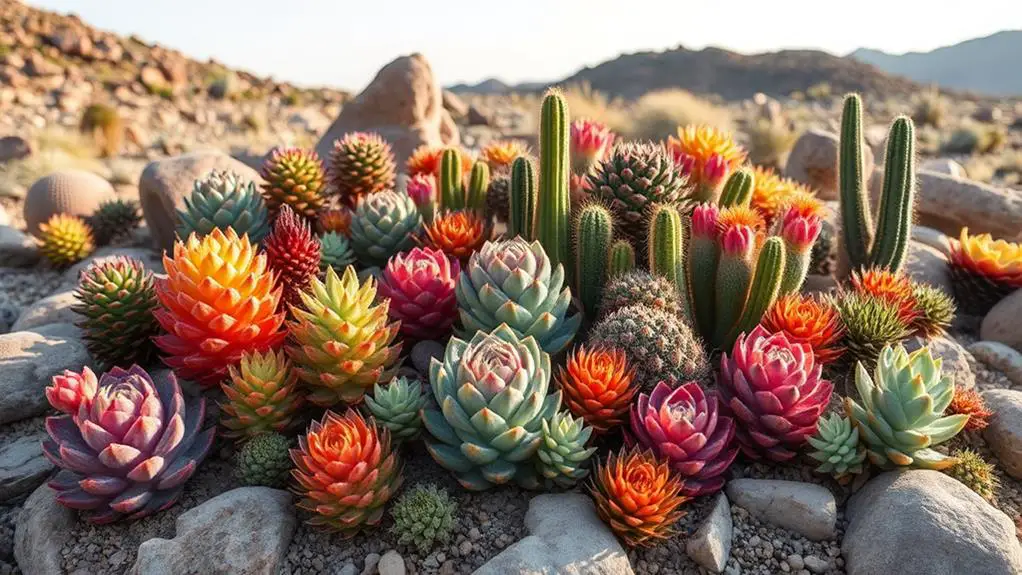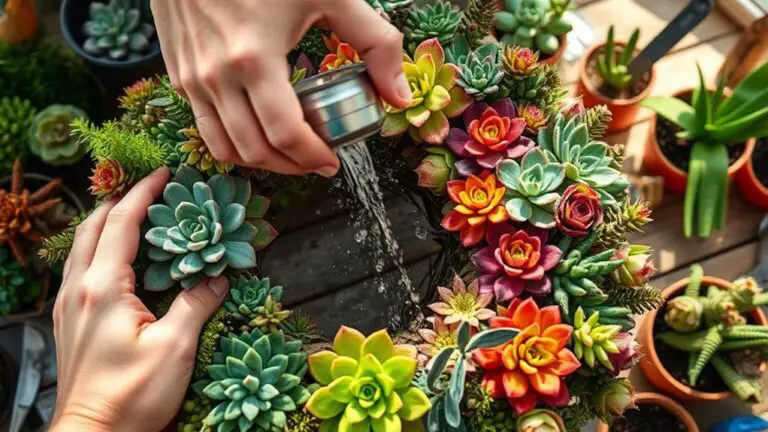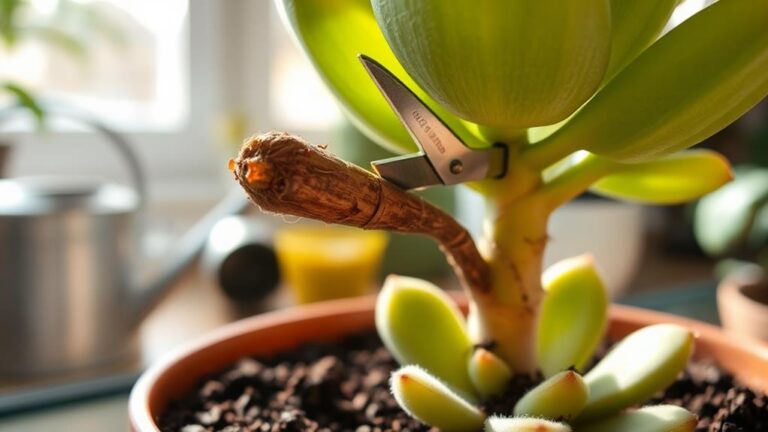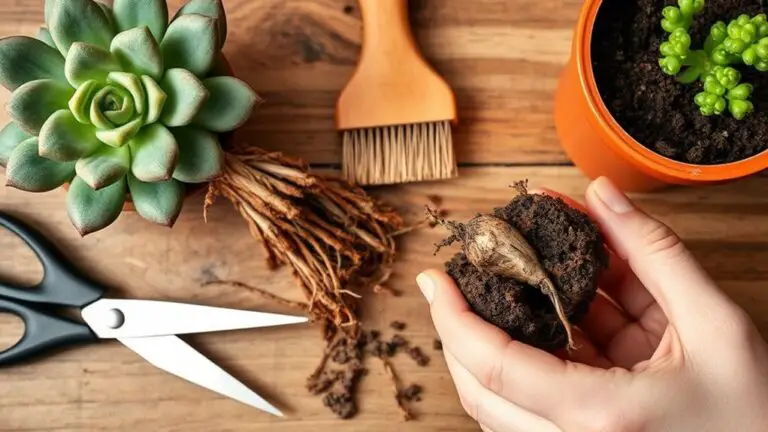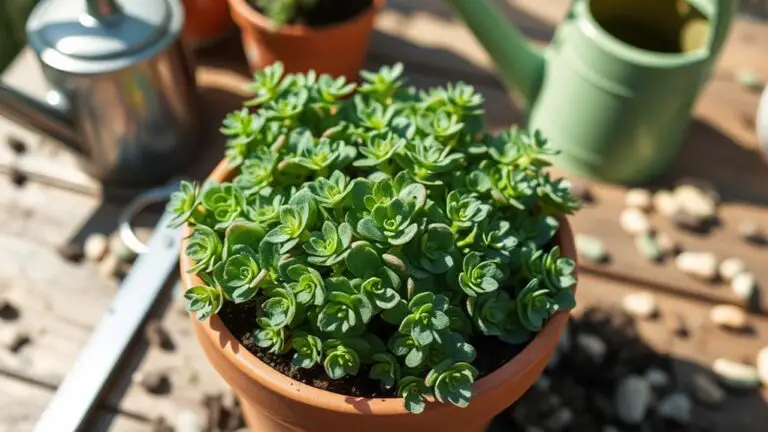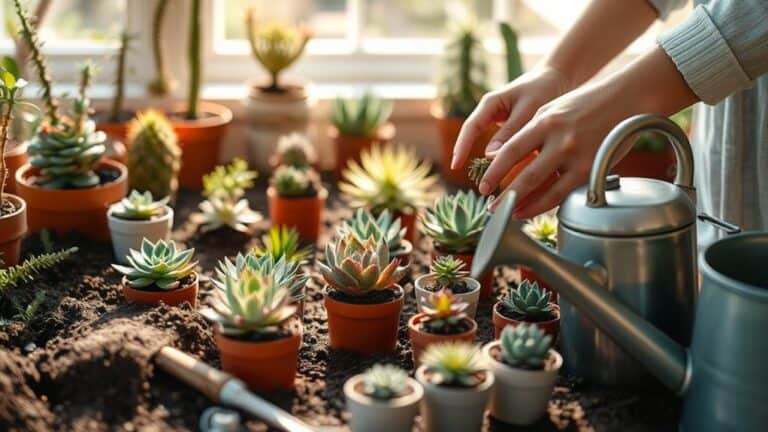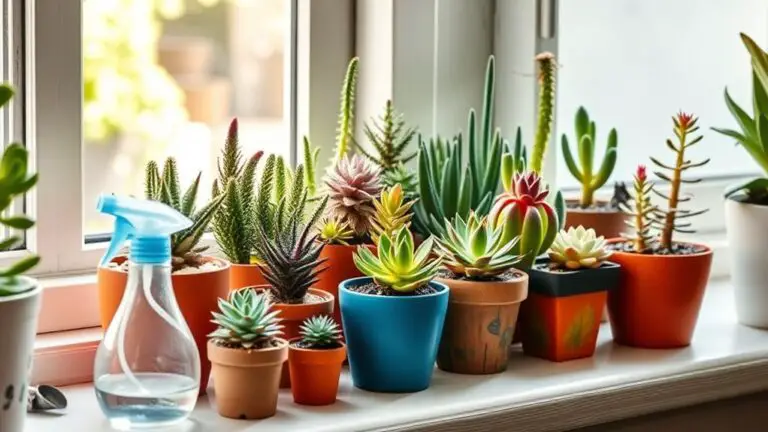5 Surprising Facts About Succulents You Didn’t Know
You might think you know all there is about succulents, but there are some surprising facts that may just change your perspective. Did you know that not all succulents bloom in their lifetime, and some, like the century plant, flower only every 10 to 15 years? You might also be surprised to learn that many succulents thrive in temperate regions, adapting to seasonal rainfall rather than desert conditions. And that's just the beginning. Stick around to uncover more about these fascinating plants, including their unique watering needs and their role in supporting local ecosystems.
Succulents Bloom Rarely

Despite their hardy nature, succulents bloom rarely, adding an element of surprise to their growth. Many succulents, like the century plant, only bloom once in their lifetime, typically every 10 to 15 years. When they do bloom, it's often spectacular, featuring large and vibrant flowers that attract pollinators. This rare event can be a highlight for any gardener.
Some species, such as Echeveria, may flower annually if given ideal conditions. These conditions include adequate sunlight and proper care. However, other succulents might never bloom during their entire lifespan. This doesn't mean your plant is unhealthy. Instead, it reflects the unique nature of each succulent species.
A blooming succulent is a sign of a healthy plant that has reached maturity and is thriving. To encourage flowering, make sure your succulents receive the right environmental conditions. This includes plenty of sunlight, well-draining soil, and regular but not excessive watering.
Not All Are Desert Plants
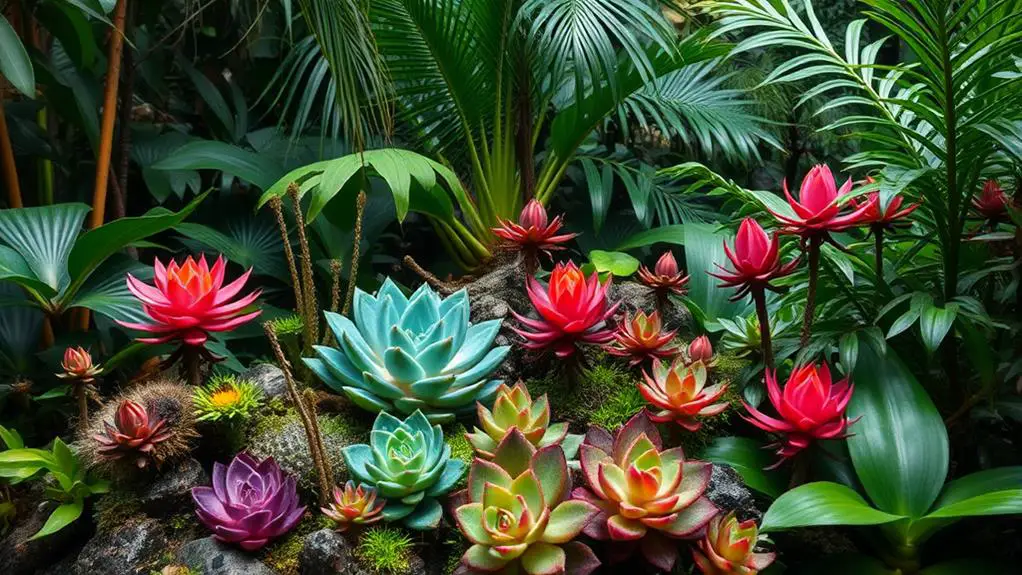
Not all succulents come from desert environments. In fact, many of these fascinating plants hail from temperate regions, particularly South Africa. These areas have seasonal rainfall, which means these succulents store moisture to survive dry periods, but they can't handle the extreme weather conditions of true desert climates.
You might be surprised to learn that:
- Temperate regions: Many succulents thrive in places with moderate climates and regular, though limited, rainfall.
- Seasonal rainfall: These plants are adapted to environments where rain comes at certain times of the year, helping them store moisture efficiently.
- "Just right" conditions: The "Goldilocks principle" applies to succulents. They need conditions that are neither too wet nor too dry.
Understanding that not all succulents come from arid regions will help you care for them better. True desert climates can actually be unsuitable for most succulents, as they often need more regular moisture than deserts provide.
When you know where your succulent originates, you can mimic its natural habitat more closely. This guarantees it gets the right amount of water and sunlight, keeping it healthy and happy.
Many Attract Pollinators
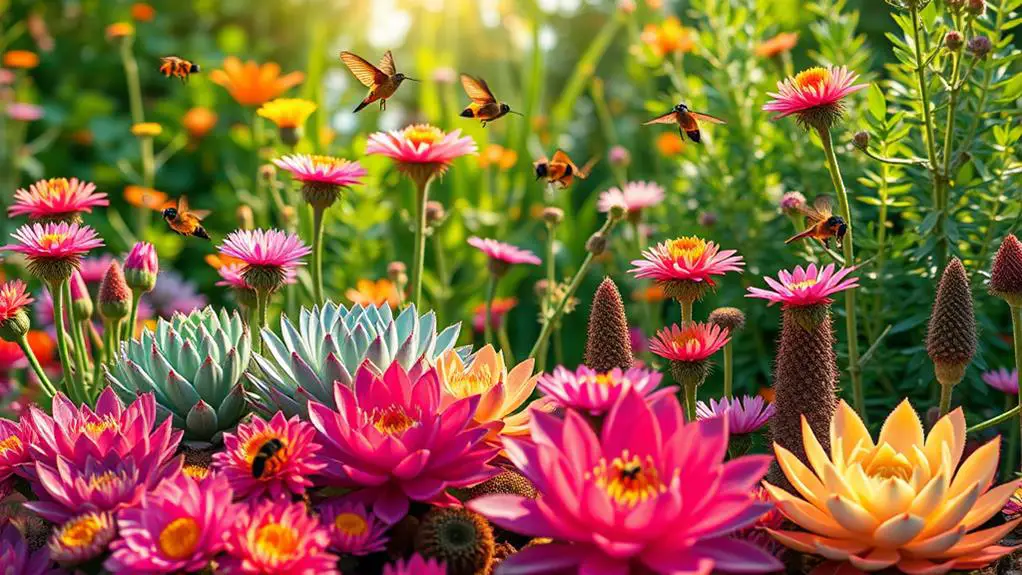
Many succulents, like Aloe vera, produce vibrant flowers that attract pollinators such as hummingbirds and bees, enhancing garden biodiversity. When you plant succulents, you're not just adding greenery to your space; you're creating a haven for pollinators. The bright, eye-catching flowers of Aloe vera and other succulents provide essential nectar sources, helping to sustain local wildlife.
Some succulents bloom at the same time as native plants. This synchronicity creates a harmonious ecosystem, making your garden a buzzing hub of activity.
You'll notice that certain species, like Echeveria, have unique flower structures. These are specially adapted to attract specific pollinators, ensuring that your garden is both beautiful and beneficial.
By planting a variety of flowering succulents, you can design a pollinator-friendly space. This not only supports plant health but also aids in wildlife conservation.
Imagine your garden filled with the vibrant colors of succulent flowers, buzzing with bees and hummingbirds. It's a simple way to boost biodiversity right in your backyard.
Cacti Are Succulents
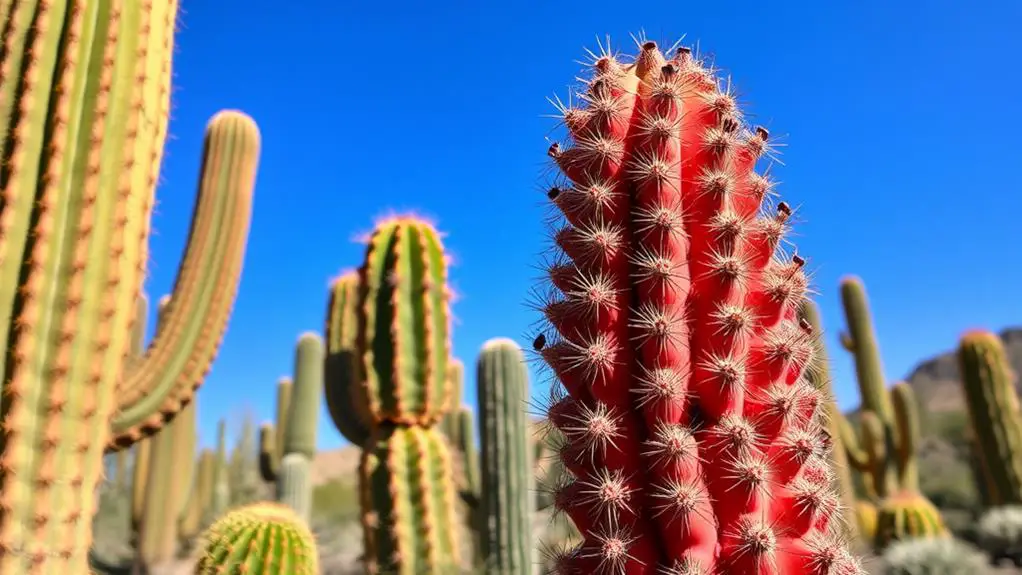
While you're attracting pollinators with your blooming succulents, it's worth noting that cacti also belong to the succulent family. All cacti are succulents, meaning they share the ability to store water in their fleshy stems. This impressive adaptation allows them to thrive in extremely arid environments.
With over 1,300 known species classified under the Cactaceae family, cacti display a wide range of shapes and sizes.
Here are three key points to help you understand why cacti are a unique part of the succulent family:
- Spines for Water Conservation: Unlike other succulents, cacti have spines instead of leaves. These spines help reduce water loss and protect the plant from herbivores.
- Light Requirements: Cacti need much light to grow and stay healthy. Make sure they get plenty of sunlight, especially if you're growing them indoors.
- Easy to Maintain: Cacti are generally easy to maintain. Their ability to store water means they can go longer between waterings, making them perfect for busy or beginner gardeners.
Understanding that cacti are succulents will help you care for them better. By providing the right amount of light and occasional watering, your cacti will grow new and thrive in your home.
Unique Watering Needs
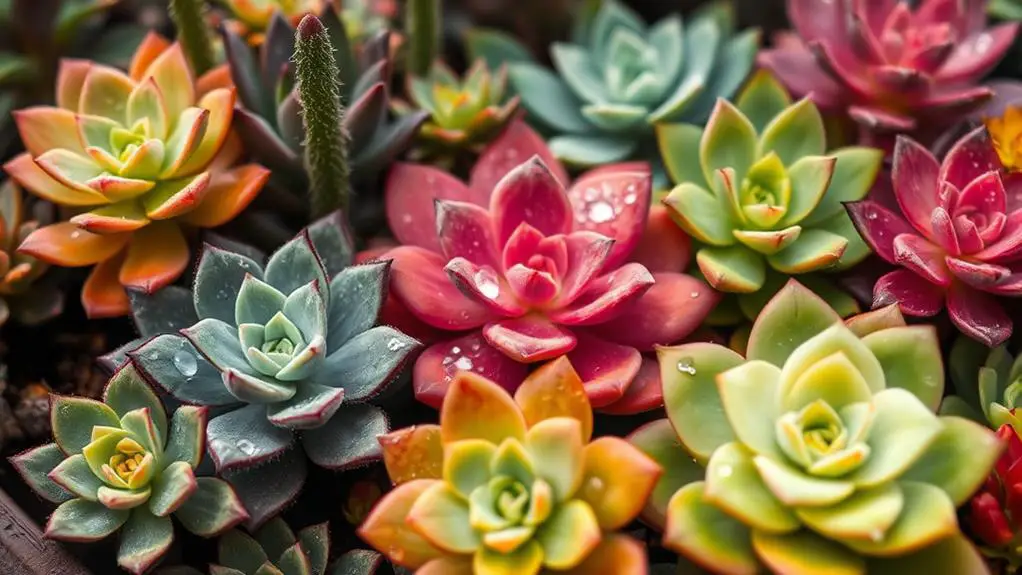
Mastering the art of watering succulents is essential for their health and longevity. Succulents have unique watering needs, and understanding them can make all the difference. One vital technique is the Soak and Dry Method. This involves soaking the soil thoroughly and then allowing it to dry completely before the next watering.
Overwatering is a common mistake. Succulents store water in their thick leaves, stems, or roots, so they don't need much water to thrive. In fact, many can go months without water. They prefer well-draining soil to avoid root rot, which can occur if water sits around their roots for too long.
The frequency of watering can vary based on your environment. Typically, you'll water them every 1-3 weeks, depending on the season and climate. During the warmer months, you might need to water more often.
Some succulent species use CAM (Crassulacean Acid Metabolism) photosynthesis, which allows them to absorb carbon dioxide at night. This process helps them reduce water loss during the day.
Frequently Asked Questions
What Are Some Fun Facts About Succulents?
You'd be amazed to know succulents can store water in their leaves, stems, or roots, letting them thrive in dry conditions for months. They use CAM photosynthesis, opening their stomata at night to save water.
What Is the Secret to Succulents?
The secret to succulents lies in their ability to store water in specialized structures and utilize Crassulacean Acid Metabolism (CAM) for photosynthesis. Their thick cuticles and diverse adaptations help them thrive in various climates, including arid environments.
What Is Special About a Succulent?
Succulents are special because they store water in their leaves, stems, or roots, letting them survive long dry spells. They use CAM photosynthesis, absorbing carbon dioxide at night to minimize water loss during the day.
What Makes a Succulent Unique?
A succulent's uniqueness lies in its ability to store water in thick, fleshy parts and its special photosynthesis process, CAM. These features help it thrive in arid and diverse environments, making it adaptable and visually appealing.
Conclusion
You've learned some surprising facts about succulents, from their rare blooms to their temperate homes. Remember, not all succulents are desert plants, and many attract helpful pollinators. Cacti are a diverse group of succulents, and they need specific watering methods. As you care for your succulents, use the "Soak and Dry Method" to keep them healthy. With this knowledge, you're ready to grow and enjoy these amazing plants. Happy gardening!

